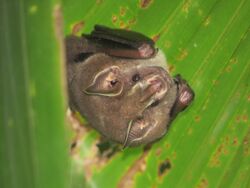Biology:Thomas's fruit-eating bat
| Thomas's fruit-eating bat | |
|---|---|

| |
| Scientific classification | |
| Domain: | Eukaryota |
| Kingdom: | Animalia |
| Phylum: | Chordata |
| Class: | Mammalia |
| Order: | Chiroptera |
| Family: | Phyllostomidae |
| Genus: | Dermanura |
| Species: | D. watsoni
|
| Binomial name | |
| Dermanura watsoni (Thomas, 1901)
| |
| Synonyms | |
| |
Thomas's fruit-eating bat (Dermanura watsoni), sometimes also popularly called Watson's fruit-eating bat,[2] is a species of bat in the family Phyllostomidae.[3] It is found from southern Mexico, through Central America to Colombia. Its South American range is to the west of the Andes.[1] The species name is in honor of H. J. Watson, a plantation owner in western Panama who used to send specimens to the British Natural History Museum, where Oldfield Thomas would often describe them.[2][4]
Taxonomy
This species was formerly placed in the genus Artibeus, but was reclassified, based on mitochondrial cytochrome b gene sequence data, in 2004. Dermanura, formerly a subgenus of Artibeus, was elevated to a separate genus. The two genera cannot be differentiated by morphology.[1][5]
Population on Isla Escudo de Veraguas
The population on the small (3.4 km2) island Isla Escudo de Veraguas off the Caribbean coast of Panama was classified as a separate species within the genus (D. incomitata, the solitary fruit-eating bat) in 1994.[6][7] It had been evaluated as critically endangered by the IUCN, being threatened by habitat loss in addition to the tiny size of its range,[8] as well as a species in danger of imminent extinction by the Alliance for Zero Extinction.[9] It was transferred to D. watsoni in 2009, based on cytochrome b data that showed it nested within watsoni.[10] The IUCN has followed this recommendation.[1] Solari et al. (2009) described it as the subspecies D. w. incomitata. They stated that "The paraphyly and specific status of watsoni/incomitata is not easily resolved" and suggested that nuclear DNA sequence comparisons would be useful.[10] The only morphological distinction between the island and mainland populations noted was differences in the cusps of the lower molars, while the DNA sequence divergence of 3.6% is less than typical for sister species in the genus.[10]
References
- ↑ Jump up to: 1.0 1.1 1.2 1.3 Solari, S. (2016). "Dermanura watsoni". IUCN Red List of Threatened Species 2016: e.T99586593A21997358. doi:10.2305/IUCN.UK.2016-3.RLTS.T99586593A21997358.en. https://www.iucnredlist.org/species/99586593/21997358. Retrieved 12 November 2021.
- ↑ Jump up to: 2.0 2.1 Beolens, Bo; Watkins, Michael; Grayson, Michael (2009-09-28). The Eponym Dictionary of Mammals. Baltimore: The Johns Hopkins University Press. p. 440. ISBN 978-0-8018-9304-9. OCLC 270129903. http://google.com/books?id=I-kSmWLc6vYC&pg=PA440.
- ↑ Simmons, N.B. (2005). "Artibeus watsoni". in Wilson, D.E.; Reeder, D.M. Mammal Species of the World: A Taxonomic and Geographic Reference (3rd ed.). Johns Hopkins University Press. p. 420. ISBN 978-0-8018-8221-0. OCLC 62265494. http://www.departments.bucknell.edu/biology/resources/msw3/browse.asp?id=13801395.
- ↑ Goldman, Edward Alphonso (1920). Mammals of Panama. Washington D.C.: Smithsonian Institution. pp. (see p. 16). https://archive.org/details/mammalsofpanamaw00gold.
- ↑ Lim, B. K.; Engstrom, M. D.; Lee, T. E.; Patton, J. C.; Bickham, J. W. (2004). "Molecular Differentiation of Large Species of Fruit-Eating Bats (Artibeus) and Phylogenetic Relationships Based on the Cytochrome b Gene". Acta Chiropterologica 6 (1): 1–12. doi:10.3161/001.006.0101.
- ↑ Kalko, E.K.V.; Handley, C.O. Jr. (1994). "Evolution, biogeography, and description of a new species of fruit-eating bat, genus Artibeus Leach (1821), from Panama". Zeitschrift für Säugetierkunde 59: 257–273. https://archive.org/details/biostor-140856. Retrieved 2018-05-20.
- ↑ Simmons, N.B. (2005). "Artibeus incomitatus". in Wilson, D.E.; Reeder, D.M. Mammal Species of the World: A Taxonomic and Geographic Reference (3rd ed.). Johns Hopkins University Press. p. 418. ISBN 978-0-8018-8221-0. OCLC 62265494. http://www.departments.bucknell.edu/biology/resources/msw3/browse.asp?id=13801366.
- ↑ Pino, J.; Samudio, R. (2012). "Artibeus incomitatus". IUCN Red List of Threatened Species 2012. https://www.iucnredlist.org/details/2133/0. Retrieved 17 May 2018.
- ↑ "A Five-Year Plan for Global Bat Conservation". Bat Conservation International. October 2013. http://www.batcon.org/pdfs/BCI%20Strategic%20Plan%202013.pdf.
- ↑ Jump up to: 10.0 10.1 10.2 Solari, S.; Hoofer, S. R.; Larsen, P. A.; Brown, A. D.; Bull, R. J.; Guerrero, J. A.; Ortega, J.; Carrera, J. P. et al. (2009). "Operational Criteria for Genetically Defined Species: Analysis of the Diversification of the Small Fruit-Eating Bats, Dermanura (Phyllostomidae: Stenodermatinae)". Acta Chiropterologica 11 (2): 279–288. doi:10.3161/150811009X485521.
Wikidata ☰ Q1834504 entry
 |


